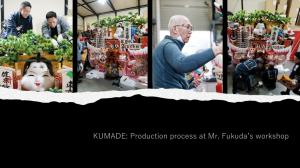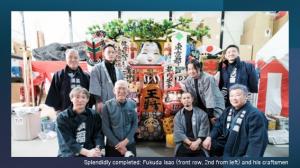
“Old Meets New”: Tokyo’s Motto Comes Alive with “Bear’s Paw” Talisman 2.0
TOKYO, JAPAN, June 26, 2025 /EINPresswire.com/ -- The ever-evolving global city of Tokyo keeps living up to its brand slogan “Old meets New.”
The Japanese capital has replaced a time-honored good luck charm—a huge, colorfully decorated rake—with a souped-up version at its landmark city hall. The old one had adorned the building’s main entrance for two decades until late December without much deterioration.
Such an object is called kumade (bear’s paw) for its spread-out shape. It has been popularly worshipped in Japan as a talisman for “raking in” good fortune and business success since the samurai era of Tokugawa shoguns (1603-1868).
In 2017, Tokyo launched the identity catchphrase in English, one year before celebrating its 150th year as the capital of modern Japan. The megacity of 14 million residents wanted to spur itself with rich traditional culture and high-tech wizardry into a better future, boosting international tourism along the way.
Thus, the Bear’s Paw, 1.0 and then 2.0, has served as a fitting symbol of this “old-meets-new” spirit right at the metropolitan nerve center.
“Holding tight to the good fortune …”
On March 29, the new-look rake, 2.5 X 2.5 meters with a 1.7-meter-long handle, was hung in the granite-walled entrance hall of the Tokyo Metropolitan Government No. 1 Building. The rake’s head is 30 centimeters wider and longer.
“The new version is bigger and spreading good fortune all around,” Tokyo Governor Koike Yuriko said. “Definitely we will be holding tight to the good fortune,” added Ms. Koike, who was elected in 2016 as the capital’s first female chief executive.
As is typical of kumade, the replacement—40 kilograms heavier at 210 kilograms—is loaded with brightly painted ornaments. They are commonly recognized as good luck symbols such as sea breams, a long-living turtle, a beckoning cat and the Shinto god Ebisu who protects fishermen.
Occupying the center spot is a comical mask of okame, a fictional female character whose white-painted, chubby-cheeked smiling face is believed to bring happiness and fortune to people around her.
Also attached are wooden plaques inscribed with standard wishes: “Tonai Anzen (Wishing for the Safety of Tokyo)” and “Senkyaku Banrai (May One Thousand Guests Come Ten Thousand Times).”
A few other plaques are added to advertise the metropolitan government’s initiatives such as a drive to enforce administrative “DX (digital transformation).” When Tokyo hosted the 2019 Rugby World Cup and the Olympics and Paralympics in 2021, the bear’s paw embraced the Games mascots.
“We all need it”: a foreign tourist
“I didn’t know what DX was all about. ‘Deluxe?’” quipped Fukuda Isao, 77, a master kumade craftsman who handmade the new version and donated it to the Tokyo Metropolitan Government (TMG) in cooperation with a society dedicated to preserve kumade markets.
“As a whole, the appearance is admirable. So, it may make visitors feel happy and join hands to pray,” Mr. Fukuda said when the new rake was installed half a year after the initial phase of designing and making parts.
Mr. Fukuda was born into a family that specialized in handcrafting kumade for some 200 years. In 2005, he single-handedly manufactured and donated the 1.0-version to the city hall.
“We have poured more time and heart into the new one, wishing for the happiness of Tokyo citizens and recovery across Japan,“ he said referring to quakes, floods and other disasters in the recent past led by the 2011 tsunami and Fukushima nuclear meltdown.
Italian tourist Denise Ragusa, 31, from Sicily said watching the exhibit, “It’s beautiful and impactful. It represents Japanese culture very well.”
Sam Saguy, 78, an Israeli professor emeritus of food technology at the Hebrew University of Jerusalem, said the rake represents a “unique combination of a lot of symbols and motifs.” “Very colorful, excellent.”
Neither of them was aware of the local belief that a kumade rake would bring prosperity and happiness. When told about this, Mr. Saguy’s wife chimed in: “We all need it.”
Bear’s paw, observatories, Guinness-listed projection mapping show
The twin-towered 48-story TMG building stands tall as one of Tokyo’s must-see tourist spots.
The bear’s paw graces the entrance hall on the second floor, which accesses a wide public road. It looks down through an atrium onto the ground-level concourse crowded with people queuing up for elevators to observatories.
The two free-of-charge observation decks are daily drawing thousands of visitors from Japan and abroad after the coronavirus pandemic.
Built in 1990 amid a cluster of high rises in the bustling business and entertainment hub of Shinjuku, the TMG headquarters offers yet another tourist attraction.
More than 700,000 people have flocked to the “TOKYO Night&Light” projection mapping show since its kickoff in February last year to energize Tokyo’s nighttime tourism.
The nightly show is screened onto the building’s façade, which resembles an integrated circuit. Global travel guide Lonely Planet compares the entire tower to a “pixelated cathedral,” while the Guinness World Records™ recognizes the project as the “largest architectural projection-mapped display (permanent).”
In a series of short audio-visual artworks,TOKYO Night&Light has featured popular Japanese themes such as the movie monster Godzilla, traditional ukiyo-e paintings and woodprints, which depict everyday life and concerns notably female beauties, and the anime robot character Mobile Suit Gundam.
The old “Edo” culture supports the evolution of Tokyo
The TMG has been actively promoting the appeal of Edo—the old name of Tokyo during the Tokugawa period. Ukiyo-e, kabuki theater and other genres of popular culture flourished in that peaceful and stable era. It created a new logo that shows old Edo and modern Tokyo sharing the same spirit.
The sense of elegance and the power of creativity from Edo continue to support the “evolution of Tokyo,” Governor Koike, re-elected to her third term last July, said. “Moving forward, we will utilize the logo to spread the attractiveness of Edo and enhance its profile with an eye on World Heritage registration.”
As part of the global post-COVID recovery, tourism is surging back in Tokyo. The numbers of foreign travelers to Tokyo and Japan at large are renewing all-time highs. This may boost Ms. Koike's policy target to make Tokyo the “best city in the world.”
Where to buy a bear’s paw
Kumade rakes have been sold at traditional fairs held on each Day of the Rooster (so designated according to the 12-day Asian animal zodiac cycle) every November at shrines and temples in eastern Japan, mainly in around Tokyo.
These Tori-no-ichi (Rooster Fairs) are said to have originated as a farmers’ harvest festival to thank their guardian deity who, according to legend, died on a Day of the Rooster in November. They traded farming tools and produce such as agricultural rakes there.
Today, not only zealous entrepreneurs but also youngsters and foreign tourists flock to Rooster Fairs, which loom like tropical jungles with stacks of colorful bears’ paws in a variety of sizes and combinations.
They usually buy one in time for New Year’s festivities and display it for one year at their homes or business locations to wish for good luck. There are about 20 sites that host Rooster Fairs held in and around Tokyo.
Ootori Shrine, a 400-year-old Shinto sanctuary in the downtown district of Asakusa, is renowned for staging a premier Rooster Fair in Tokyo. Mr. Fukuda, who has handmade the two rakes for the city hall, sets up several of the nearly 90 kumade stalls there every November.
On November 5, endless streams of people swarmed the first Rooster Fair of 2024 at the shrine around the clock. Many of them usually buy rakes from their favorite vendors, raising their size each year.
“Unusual business”: no price tags attached
“This is an unusual business. No price tags can be attached,” confided Mr. Fukuda, who heads the association of kumade vendors in Asakusa. “Some people pay 50,000 yen ($340) and the others 100,000 yen for the same item. It’s up to the customers.”
Takada Hideju, 63, who owns a gift and novelty company in downtown Tokyo, has bought rakes from Mr. Fukuda’s main stall for 20 straight years, bigger and bigger each time. “I display it in my office. It sure makes me feel good,” he said.
He paid 63,000 yen including a 20,000-yen courteous tip for a rake, sized 75 X 75 centimeters with a 120-centimter-long handle.
As is customary, when the seller and buyer agreed on a price, they rhythmically clapped their hands together dozens of times to celebrate the conclusion of a deal. Such boisterous jubilations echoed well into the night.
Ootori Shrine’s chief priest Kono Mototoshi, 71, said almost all of the Rooster Fair shoppers were merchants and traders in the past. “We see more and more young people and foreigners coming. They are behaving well.”
During the COVID outbreak the number of visitors was restricted to one 10th of the normal-time average of around one million, the priest said. The turnout is returning to the pre-pandemic level.
No time to retire
Like the Shinto priesthood, the Fukuda family’s profession has been handed down from father to son since it was founded in Ashikaga, a provincial city some 100 kilometers north of Tokyo. Fukuda Isao’s grandfather moved his workshop about 100 years ago to the northern fringe of Tokyo where many of his competitors plied their trade.
“We have no reference books at all. We just make stuff the way we like it. In this way, we add taste to what we make,” Mr. Fukuda said at his studio in a fast-developing bedroom community in Tokyo’s northern suburbs. His family ‘s cottage industry was relocated there half a century ago.
He recalled that his father had established a distinctive kumade style that is now mainstream among the nearly 100 kumade makers in the eastern Japan region. “In his will, my father told me to make kumade that can be imitated by others.”
His seniors, including his now deceased older brother, never gave him any formal apprenticeship. “They wouldn’t teach you how, so I had to watch and copy them.”
He has secured a successor in his son, 50, who has been his right-hand man for years. But the elder Fukuda, pushing age 78, has no immediate plan to retire. “Work comes first,” he wrote in a New Year’s resolution this year.
When asked if he had many more years to work, he replied: “If possible.”
A personal note
This writer happened to have shared the boyhood with Mr. Fukuda, a mischievous kid two years my senior, in a less affluent Tokyo neighborhood, not so long after World War II.
Part of Japan’s postwar baby-boomer generation (born 1947-1949), we watched Tokyo’s miraculous restoration from one side of the wide Arakawa River, which separates the city’s center from outlying areas. Tokyo hosted the Olympics in 1964 and in 2021.
“We had to cross the bridge to reach the ‘real’ Tokyo,” Mr. Fukuda smiled. Both of us clearly remember the four tall smokestacks at a coal-fired Tokyo Electric Power plant, which was demolished in 1963.
Now, from the river’s embankment, the 634-meter Tokyo Skytree broadcasting and observation tower can be seen soaring behind where the power plant used to stand.
Mr. Fukuda and this writer, a coal miner’s son from a northern island, lost each other’s tracks in our mid-teens, either climbing the ladder in traditional craftmanship or venturing into international communications.
The Bear’s Paw 2.0 has brought us back together in our golden years—as if by magic.
Strategic PR Section, Strategic PR Div.
TOKYO METROPOLITAN GOVERNMENT
email us here
Distribution channels: Business & Economy, Culture, Society & Lifestyle, Environment, Gifts, Games & Hobbies, Travel & Tourism Industry
Legal Disclaimer:
EIN Presswire provides this news content "as is" without warranty of any kind. We do not accept any responsibility or liability for the accuracy, content, images, videos, licenses, completeness, legality, or reliability of the information contained in this article. If you have any complaints or copyright issues related to this article, kindly contact the author above.
Submit your press release




